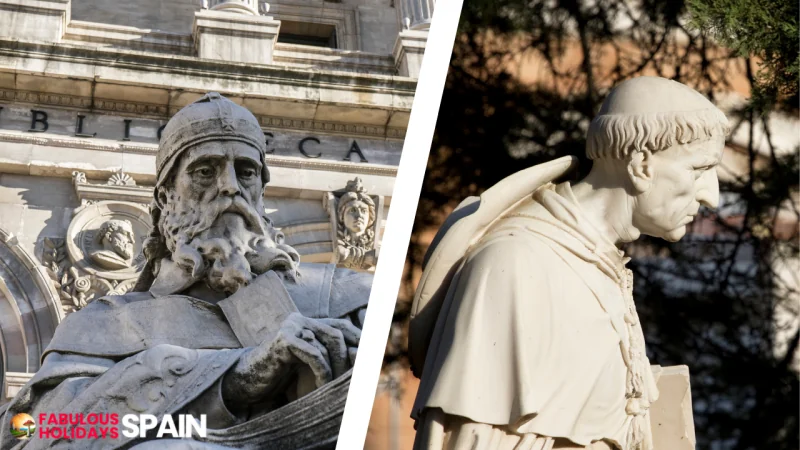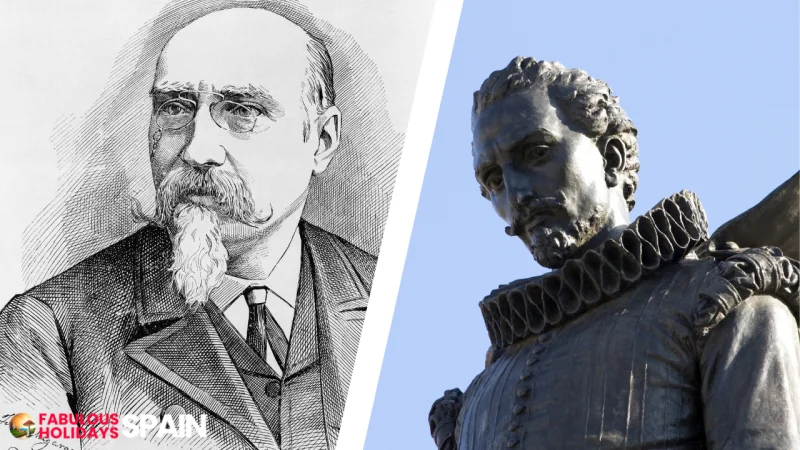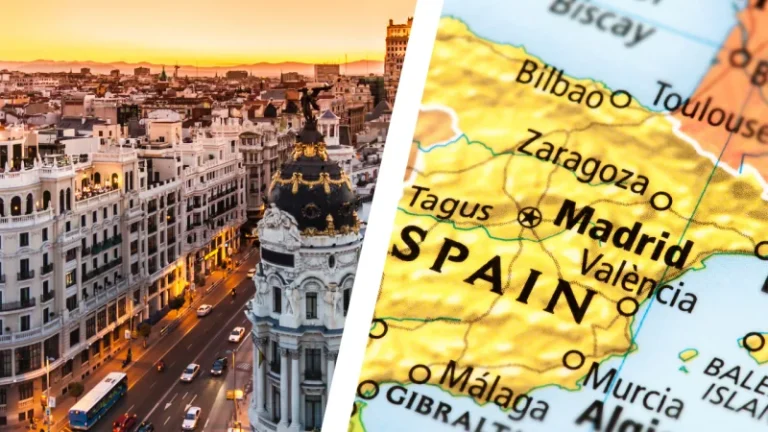Spanish Authors and Spanish Literature
What are the Periods of Spanish Literature?
Spanish literature boasts a rich and diverse history, spanning over 1,000 years and encompassing various genres, styles, and themes.
Its evolution can be divided into distinct periods marked by its unique characteristics and cultural influences.
Spanish literature dates back to the Middle Ages, with the ‘Cantar de Mio Cid’ being one of the earliest known works.
Source
Medieval Period (8th-15th centuries)
This period encompasses the formative years of Spanish literature, characterized by the flourishing of oral traditions and the emergence of written works in Castilian, the language that would eventually become the standard form of Spanish.
Notable works include the epic poem “Cantar de Mio Cid,” the religious lyric poetry of the Cantigas de Santa Maria, and the allegorical prose of “El Libro de Buen Amor.”
Renaissance (16th-17th centuries)
This period marks Spain’s cultural and intellectual Golden Age, known as the Siglo de Oro. Inspired by classical models, Spanish Renaissance literature flourished in all genres, particularly poetry, drama, and prose.
Literature is the denunciation of the times in which one lives.
– Camilo Jose Cela
Miguel de Cervantes, with his groundbreaking novel “Don Quixote,” stands as the preeminent figure of this era. Other notable authors include Lope de Vega, Tirso de Molina, and Francisco de Quevedo.
Baroque (17th century)
Following the Renaissance, the Baroque period brought a new emphasis on ornamentation, complexity, and emotional intensity.
Spanish Baroque literature is characterized by its use of rhetorical devices, its exploration of religious and philosophical themes, and its focus on the complexities of human nature.
Notable Baroque authors include Baltasar Gracián, Pedro Calderón de la Barca, and Sor Juana Inés de la Cruz.
Enlightenment (18th century)
The Enlightenment era shifted towards rationalism, empiricism, and a questioning of traditional values. Spanish Enlightenment literature reflected these intellectual trends, promoting scientific inquiry, social reform, and the ideals of liberty and equality.
Notable Enlightenment authors include Benito Jerónimo Feijoo, Gaspar Melchor de Jovellanos, and José Cadalso.
Spanish literature encompasses works from Spain as well as Latin America, with Gabriel Garcia Marquez, a Colombian author, being a notable figure in Latin American literature.
Source
Romanticism (19th century)
Romanticism emphasized emotions, individuality, and the beauty of nature. The European Romantic movement deeply influenced Spanish Romantic literature, exploring themes of love, loss, national identity, and rebellion against social norms.
Notable Romantic authors include José de Espronceda, Gustavo Adolfo Bécquer, and Rosalía de Castro.
Realism and Naturalism (19th-20th centuries)
Realism and Naturalism emerged as literary movements that sought to portray reality objectively and precisely.
Spanish realist and naturalist authors depicted their time’s social and economic realities, often focusing on the lives of ordinary people and the injustices they faced.
Notable realist and naturalist authors include Benito Pérez Galdós, Leopoldo Alas (Clarín), and Emilia Pardo Bazán.
Generation of 1898 (20th century)
The Generation of 1898 was a group of Spanish intellectuals and writers who emerged after Spain’s defeat in the Spanish-American War.
They were deeply critical of Spain’s political, social, and cultural decline, and their works often explored themes of national identity, disillusionment, and the search for meaning in a world in disarray.
Miguel de Unamuno, Antonio Machado, and José Ortega y Gasset are notable members of the Generation of 1898.
Generation of 1927 (20th century)
The Generation of 1927 was a group of Spanish poets who sought to revive the modernist movement in Spain. They were influenced by various literary and artistic trends, including Symbolism, Futurism, and Surrealism.
Notable members of the Generation of 1927 include Federico García Lorca, Jorge Guillén, and Rafael Alberti.
Contemporary Literature (20th-21st centuries)
Contemporary Spanish literature continues to explore various themes, styles, and genres. It reflects the diversity of Spanish society and the ongoing influence of global trends.
Notable contemporary Spanish authors include Javier Marías, Juan Goytisolo, Carmen Martín Gaite, and Almudena Grandes.
To fall into a habit is to begin to cease to be.
– Miguel de Unamuno
What are the Important Books from Spanish Literature
Spanish literature is a treasure trove of timeless masterpieces, spanning over a millennium and encompassing various genres, styles, and themes.
Here are some of the most important books from Spanish literature, written in simple language:
Cantar de Mio Cid (Song of My Cid)
This epic poem, written in the 12th century, tells the story of Rodrigo Díaz de Vivar, a Castilian nobleman who fought against the Moors during the Reconquista. It is considered one of the foundational works of Spanish literature.
La Celestina (Calisto and Melibea)
This tragicomic play, written in the 15th century, is a complex and thought-provoking exploration of love, desire, and betrayal.
It is considered one of the most important works of Spanish Renaissance literature.
Don Quixote
This satirical novel, written by Miguel de Cervantes in the 17th century, is a classic of world literature.
It tells the story of an idealistic knight-errant who sets out to revive chivalry in a modern world that doesn’t understand him.
Lazarillo de Tormes
This picaresque novel, written anonymously in the 16th century, is a social satire that follows the adventures of a young boy who must survive by his wits in a harsh and unforgiving world.
Fuenteovejuna
This play, written by Lope de Vega in the 17th century, is a powerful drama about a group of peasants who rise against their tyrannical lord.
Don Juan Tenorio
This play, written by José Zorrilla in the 19th century, is a classic of Spanish Romanticism. It tells the story of a womanizing nobleman who is ultimately punished for his sins.
La Regenta
This novel, written by Leopoldo Alas Clarín in the late 19th century, is a psychological novel that explores the moral dilemmas of a young woman trapped in a stifling social environment.
Nada
This novel, written by Carmen Laforet in the 1940s, is a coming-of-age story that depicts the struggles of a young woman in post-Civil War Spain.
La casa de Bernarda Alba
This play, written by Federico García Lorca in the 1930s, is a tragic drama about five sisters who are confined to their home by their domineering mother.
Cien años de soledad (One Hundred Years of Solitude)
Gabriel García Márquez wrote this novel in the 1960s. It is a magical realist masterpiece that tells the story of the Buendía family over seven generations.
Spain is the fourth largest publisher of books in the world, producing over 86,000 titles in 2018.
Source
Who are the Most Important Writers of Spanish Literature?
Spanish literature has a rich and diverse history, spanning centuries and encompassing various genres and styles.
From medieval romances to contemporary novels, Spanish writers have continuously captivated readers worldwide with their creativity, wit, and profound insights into the human condition.
Among this vast array of literary luminaries, several are particularly influential and significant figures who have left an indelible mark on the world of literature.
Miguel de Cervantes (1547-1616) is widely regarded as the greatest Spanish writer of all time. His masterpiece, Don Quixote, is considered the first modern novel and is renowned for exploring human folly, idealism, and the clash between reality and imagination.
Cervantes’s works have profoundly impacted literature worldwide and continue to be studied and enjoyed by readers today.

Lope de Vega (1562-1635) is a prolific playwright who is credited with shaping Spanish Golden Age theatre. His works, characterized by their vivid characters, love stories, and historical settings, have been performed and admired for centuries.
Lope de Vega’s plays remain popular and influential in Spanish-speaking countries, and his contributions to the theatre have earned him a place among the greatest playwrights in history.
Federico García Lorca (1898-1936) was a renowned poet, playwright, and essayist who is considered a central figure in Spanish modernism.
His works, marked by their lyrical beauty, social commentary, and exploration of themes such as death and love, profoundly impacted Spanish and Latin American literature.
García Lorca’s tragic death in the Spanish Civil War further cemented his legacy as a cultural icon and a symbol of the struggle for freedom and justice.
How Did Spanish Culture Affect Spanish Literature?
Spanish culture has had a profound and lasting impact on Spanish literature, shaping its themes, styles, and the very language used to convey its stories.
Here are some key ways in which Spanish culture has influenced Spanish literature:
Historical and Social Influences
Spanish literature is deeply rooted in the country’s history and social fabric.
From the epic poems of the Reconquista to the social commentary of the Generation of ’98, Spanish writers have drawn inspiration from their nation’s rich history.
The themes of love, loss, identity, and the struggle for freedom are recurrent in Spanish literature, reflecting the country’s turbulent history and its people’s resilience.
Language and Expression
Spanish literature is characterized by its vibrant and expressive use of language.
The Spanish language itself is a rich and nuanced instrument, and Spanish writers have masterfully employed its poetic qualities, metaphors, and wordplay to create vivid imagery and convey complex emotions.
Spanish literature’s language reflects the Spanish people’s diversity and their cultures, from the colloquialisms of everyday life to the elaborate expressions of formal poetry.
Regional and Local Influences
Spain’s diverse regions and cultures have also shaped its literature. Each region has its own unique traditions, folklore, and dialects, which have been incorporated into Spanish literature.
Regional writers have often explored themes of local identity, customs, and the relationship between the individual and their community.
This regional diversity has enriched Spanish literature with its various voices, perspectives, and literary styles.
The ‘Don Quixote’ by Miguel de Cervantes, a Spanish author, is considered one of the finest works of literature ever written and has been translated into over 50 languages.
Source
Artistic Movements and Innovations
Spanish literature has been influenced by various artistic movements, from the idealism of the Renaissance to the realism and naturalism of the 19th century.
These movements have introduced new techniques, styles, and themes to Spanish literature, keeping it dynamic and evolving.
The pursuit of innovation has been a hallmark of Spanish writers, who have continuously pushed the boundaries of language and storytelling.
Global Connections and Influence
Spanish literature has not been confined to Spain’s borders; it has engaged with and influenced the wider world.
From the cultural exchanges of the Spanish Empire to the global influence of Latin American literature, Spanish writers have drawn inspiration from diverse cultures and perspectives.
This openness to the world has enriched Spanish literature with new ideas, characters, and settings, broadening its appeal and global reach.
What are the Must-See Literary Museums in Spain?
Spain has a rich literary heritage, and many museums are dedicated to celebrating the works and lives of famous Spanish writers. Here are a few of the must-see literary museums in Spain:
Casa Natal de Miguel de Cervantes:
Casa Natal de Miguel de Cervantes: This museum in Alcalá de Henares, Cervantes’s birthplace, houses a collection of his personal belongings, manuscripts, and other artefacts.
Lope de Vega House Museum
This museum in Madrid is located in the house where Lope de Vega, Spain’s most prolific playwright, lived for 26 years. The museum contains a collection of his manuscripts, costumes, and other personal items.
Museo del Romanticismo
This museum in Madrid is housed in a beautiful 18th-century palace and offers a fascinating glimpse into the world of Romanticism in Spain. The museum’s collection includes paintings, sculptures, furniture, and other objects from the Romantic period.
Museo Lázaro Galdiano
This museum in Madrid is a treasure trove of Spanish art and literature. The museum’s collection includes paintings, sculptures, furniture, manuscripts, and other objects from the 15th to the 20th centuries.
Biblioteca Nacional de España
This national library in Madrid is home to one of the world’s largest collections of Spanish literature. It offers guided tours and other programs for visitors.
The ‘One Hundred Years of Solitude’ by Gabriel García Márquez, a Spanish-language author, has sold over 50 million copies worldwide.
Source
What are the Most Popular Spanish Newspapers?
These are the top 10 most popular Spanish newspapers in 2024, based on circulation:
- Marca: A sports newspaper with a focus on football (soccer).
- El País: A center-left daily newspaper with a national and international focus.
- El Mundo: A centre-right daily newspaper with a national and international focus.
- La Vanguardia: A Catalan daily newspaper with a national and international focus.
- ABC: A conservative daily newspaper with a national and international focus.
- La Razón: A conservative daily newspaper with a national and international focus.
- Cinco Días: A business newspaper with a national and international focus.
- El Economista: A business newspaper with a national and international focus.
- La Nueva España: A regional daily newspaper in Asturias, Spain.
- Diario Sur: A regional daily newspaper in Andalusia, Spain.






